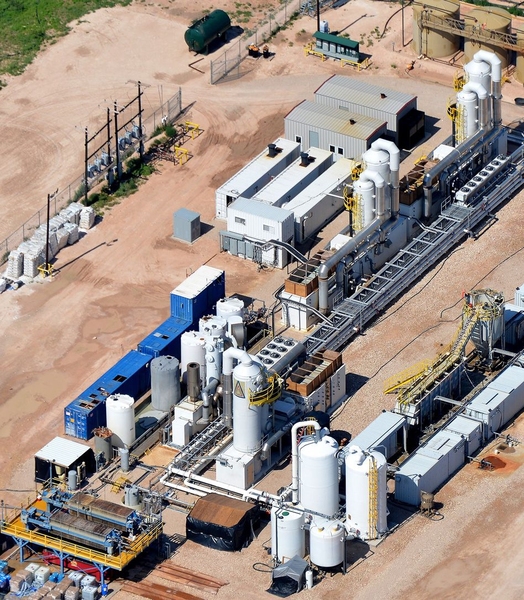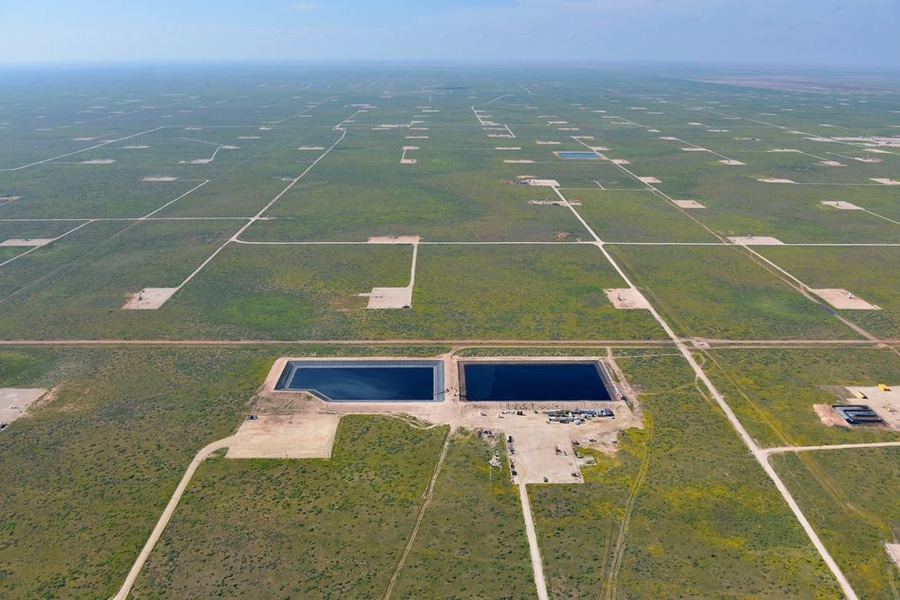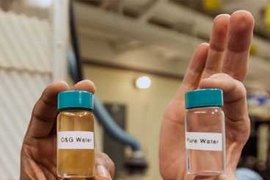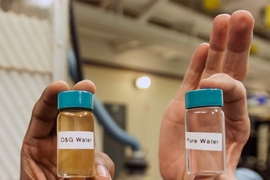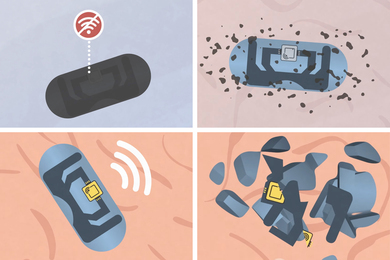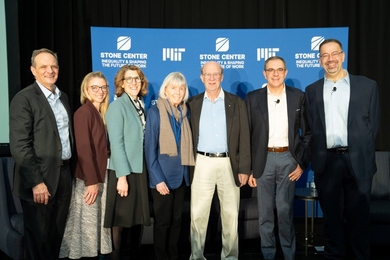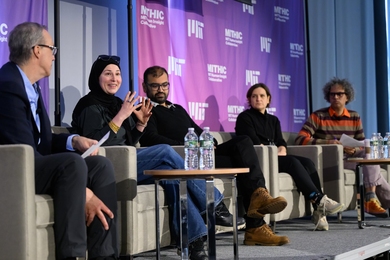Hydraulic fracturing, or “fracking,” produces a lot of wastewater. Drilling one well requires millions of gallons of water that’s injected into the ground to loosen rocks and release oil. While some is reused, much of the produced water is discarded into deep injection wells, and clean water is purchased again and again.
But MIT spinout Gradiant Corporation is working toward making fracking a water-neutral process, by making water reuse more economical. Founded by Anurag Bajpayee SM ’08, PhD ’12, and Prakash Govindan PhD ’12, Gradiant has developed cost-effective systems to treat briny oilfield water for reuse, saving millions of gallons of water — and millions of dollars — annually.
Launched in 2012 with help from MIT’s industry-connected ecosystem, Gradiant has erected two 12,000-barrel-per-day plants in the Permian Basin of Texas, partnering with two drilling clients who treat about 10,000 barrels daily there. “That’s 10,000 barrels a day they’re not disposing of, and 10,000 they’re not buying from the city or taking off the public water supply,” says Bajpayee, now Gradiant’s CEO.
The plants each use separate technologies that treat varying infeed water, which can be adjusted to customer specifications. Carrier gas extraction (CGE), a humidification and dehumidification (HDH) technique developed by the Gradiant co-founders at MIT, heats produced water into vapor, and condenses it back into water, without contaminants. This yields freshwater and saturated brine, commonly used in drilling and completion processes.
Selective chemical extraction (SCE) is a cost-effective version of standard chemical-precipitation techniques — where chemical reactions remove specific contaminants to produce clean brine. Both systems employ custom control algorithms that minimize operator intervention and chemical consumption, while continuously adjusting the process to account for varying feed water quality.
Thanks to several design innovations, these systems can treat water with higher levels of contamination using less energy and at lower costs than competing treatment methods, according to Gradiant.
Reverse osmosis, for example, treats water with a maximum contamination level of around 7 percent, while legacy thermal desalination reaches about 20 to 22 percent. But Gradiant’s technology uses even less energy to treat water beyond 25 percent, broadening the range of water that can be treated, Bajpayee says. “Our technology is unique in its capability of going through true saturation limits … to the point where you can actually start seeing crystals in the water,” he says.
Commercializing HDH
HDH is a decades-old concept: Water is vaporized and condensed on a cold metallic surface to remove salts. But commercial-scale systems have always been too energy-intensive, because water must be boiled while condensing surfaces must be kept very cold.
But Gradiant’s system — designed by Govindan and colleagues in the lab of Gradiant co-founder John H. Lienhard, the Abdul Latif Jameel World Water and Food Security Professor at MIT — scaled well by using a readily available carrier gas (dry air) that vaporizes water below boiling temperatures, and incorporating a column with microbubbles that optimizes condensing surfaces.
In the Gradiant system’s humidifier chamber, briny water drops through packing material and mixes with dry air to produce a hot and humid vapor stripped of contaminants — such as salts — that forms at the top of the chamber. “We creatively mimic nature’s rain cycle — we create the cloud and then we condense that water back out to create rain,” Bajpayee says.
This “raining” happens in a bubble column, which has several levels of perforated trays, each containing a shallow pool of freshwater. As vapor rises through the bubble column, it passes through the plates’ holes, causing an extremely rapid mixing process that cools and condenses the water within the pools. As levels rise, the water overflows and is captured in a tray as fresh, nearly distilled water.
The temperature difference between the warm and cool water is much less than in a conventional dehumidifying system, using less energy, and the surface area provided by the microbubbles in the trays offers a more efficient heat-transfer ratio than a flat, metallic condenser surface. Not using expensive materials, such as titanium, in the heat exchanger also reduces the capital costs.
Heated water is also reused to preheat incoming feed water. Instead of fully heating the incoming water to the desired temperature, Bajpayee says, “you only have to make up the little bit that you couldn’t recover,” which saves energy.
Working alongside industry
Gradiant’s rapid ascension, Bajpayee says, is thanks in large part to MIT’s entrepreneurial ecosystem, which connects researchers to mentors, industry, and investors. “Every day you learn something new, or meet a new contact, that adds to what you knew the previous day, and it all builds upon itself,” he says. “Before you know it, you’re in a completely different place then where you started.”
Indeed, Bajpayee and Govindan met in the late 2000s while working on separate water-treatment technologies in MIT’s Rohsenow Kendall Heat Transfer Laboratory. The oil and gas industry were then heavily investing in fracking, leading to outcries about wastewater.
The solution was in Govindan’s PhD thesis, in which he fleshed out a CGE system with dry air and a bubble column. Based on this work, Govindan, MIT engineers, and collaborators at King Fahd University of Petroleum and Minerals built a 12-foot-high prototype, which produced about 700 liters of clean water per day. (The system’s design was described in papers published in the International Journal of Heat and Mass Transfer, Applied Energy, and the AIChE Journal.)
Soon, Bajpayee teamed with Govindan on the system, and they began reaching out to different industries — oil and gas, leather, and power plants — for feedback. “Because we wanted to see the societal and commercial impact of our work, we started seeing what was happening in the industry, and then started … asking them how to solve their problems,” Bajpayee says.
Through the MIT Deshpande Center for Technological Innovation, the team also began connecting with investors. This constant contact with industry, Bajpayee says, gradually helped refine the system for commercial use. “We did not develop something and try to market it to our customers,” he says. “It was developed along with the customers, so by the time we were ready to start the company, there were already people lined up who wanted to use it.”
That’s why in two years the startup has managed to build two plants, and commercialize two product lines. It also has three additional water-treatment technologies — one based on Bajpayee’s PhD thesis — under development that could be commercialized in the next two years.
Although Gradiant’s first market is the oil industry, it plans to introduce its technologies to different industries across the globe — wherever there’s incentive to recycle highly contaminated water, according to the company.
Moving forward, says Govindan, Gradiant’s chief technology officer, the company will stay focused on making water treatment and recycling more energy efficient for the oilfield and other industries — an enduring philosophy from his alma mater. “At the core of everything is research and development,” he says. “That holds from the MIT days.”


